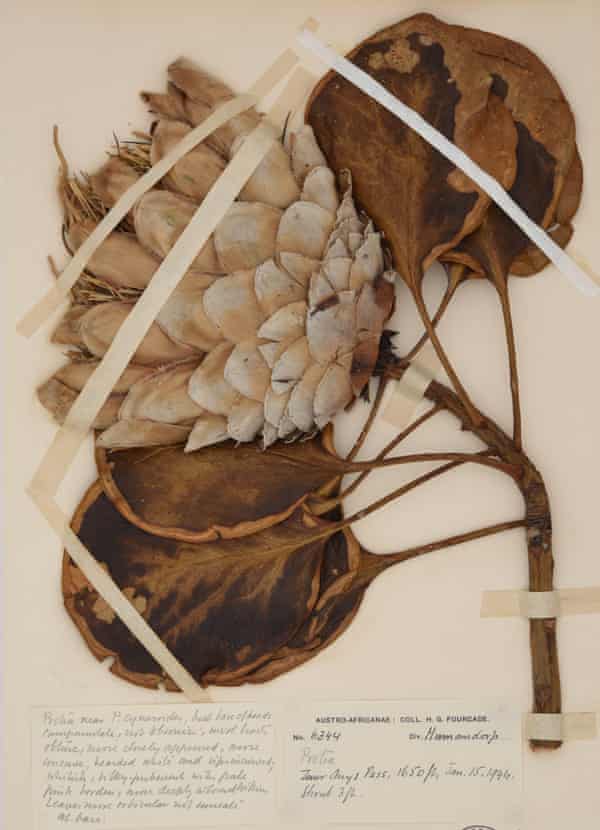The fire that started on the slopes of Table Mountain on April 18 this year quickly swept through the University of Cape Town campus. The world watched in horror as the African Studies Library was burned to the ground. In the weeks that followed, volunteers waded through the waterlogged basement of the razed building to see which rare books had survived.
What few people beyond the university realised at the time is that barely 100 metres away the Department of Biological Sciences had also suffered catastrophic losses. “We’ve lost everything,” says Prof Timm Hoffman, the director of the Plant Conservation Unit (PCU), which was housed in a “highly flammable wooden turret” on the roof of the HW Pearson building.
One look at the blackened wreckage just over two months later confirms he is not exaggerating. “It’s too painful,” he says. “I was in that office for 20 years. I did my PhD in the room next door. I’ve probably spent more time in that building than I have in my own home.”
In addition to seeing all of their books, computers, scanners, microscopes and other equipment go up in smoke, the PCU’s entire collection of photographs was destroyed in the fire. The oldest photographs dated back to 1876. And these were not just any photos. “As an ecological historian, my entire discipline is based on historical photographs,” says Hoffman. “Photos are like little time machines. Each image is rich, rich, rich with information about the environment.”
By comparing then-and-now photos of the same landscape, Hoffman and his colleagues specialised in documenting how landscapes changed over time. “Comparing pics of the same landscape can tell you about the nature of the change, the extent of change and the rate of change,” he says. “We use the past to understand the present so we can make predictions about the future.”
Often their findings are not what you’d expect. For example, for much of the 20th century ecologists believed the semi-desert expanse of the Karoo was expanding into the Free State grasslands as a result of overgrazing. But the PCU’s work with repeat photography showed the opposite: the eastern Karoo has in fact become more grassy over the past 30 years as a result of an increase in rainfall and fewer animals grazing the veld.
Luckily, after joining the university in 2000, Hoffman invested in the digitisation of the photographic archive. Although he is yet to muster the courage to go through the digital databases – “I’m still grieving,” he says – he estimates that 30,000 images have been digitised and that he has at least one image for 90% of his most important sites. But only 10% of another collection of 35,000 slides had been digitised. “If we’d invested in bigger, faster scanners we could have finished by now,” he laments. “But I’m also very proud that we digitised at all. Not many ecologists are focused on digital archives. No one else has a collection like this in Africa.”
The flagship of the PCU’s digitisation efforts is rePhotoSA, a geolocated, online database of then-and-now landscape photographs of southern Africa, which was developed in conjunction with the Animal Demography Unit at the university. Of the 30,000 historic photos in the database, fewer than 10% currently have contemporary partners. This is where citizen scientists come in, as the public are encouraged to add to the database of repeats. Finding an exact match is not always easy (guidelines help a lot) but can be hugely satisfying. Anyone with a collection of old landscape photographs is encouraged to get in touch.
The PCU was not the only department in Biological Sciences to be affected by the fire. The Institute for Communities and Wildlife (ICWild) was also severely damaged. Fortunately, hard drives containing much of its data on how animals such as baboons and caracals are able to adapt to urbanisation were housed in another part of the building.
In what Prof Tony Verboom describes as “a miracle”, the Bolus Herbarium – situated directly below ICWild – and its adjoining botanical library suffered only minor water damage. With more than 350,000 specimens, the Bolus has one of the world’s most important collections of Cape flora, including about 12,000 type specimens – the single specimen upon which a scientific name is based.
“A type specimen provides the reference point for plant names. Without them our taxonomic classifications lose their roots in reality,” says Verboom. “Believe it or not, we’re still reeling from the loss of the Berlin herbarium in the second world war …”

While the fire caused untold damage, even Hoffman can see that it could have been a lot worse. “It’s a serious wake-up call,” he says. “We have to do everything we can to prevent a repeat.” This includes ensuring buildings are fire-safe, installing high-pressure fire hoses (instead of relying on the city fire department) and monitoring what kind of vegetation grows on campus. “As a botanist, I should have known that the palm tree next to our building was a fire hazard,” he says. “I should have brought my chainsaw and cut it down myself.”
While the steps outlined above are important, Hoffman and Verboom agree that the biggest non-negotiable for academics the world over is to create secure, cloud-based backups of all their data. “When the fire struck we’d already started photographing all the samples in the herbarium,” says Verboom. “But now we’re going full steam ahead. A photo isn’t the same as a physical specimen. But it’s a lot better than nothing.”
Find more age of extinction coverage here, and follow biodiversity reporters Phoebe Weston and Patrick Greenfield on Twitter for all the latest news and features